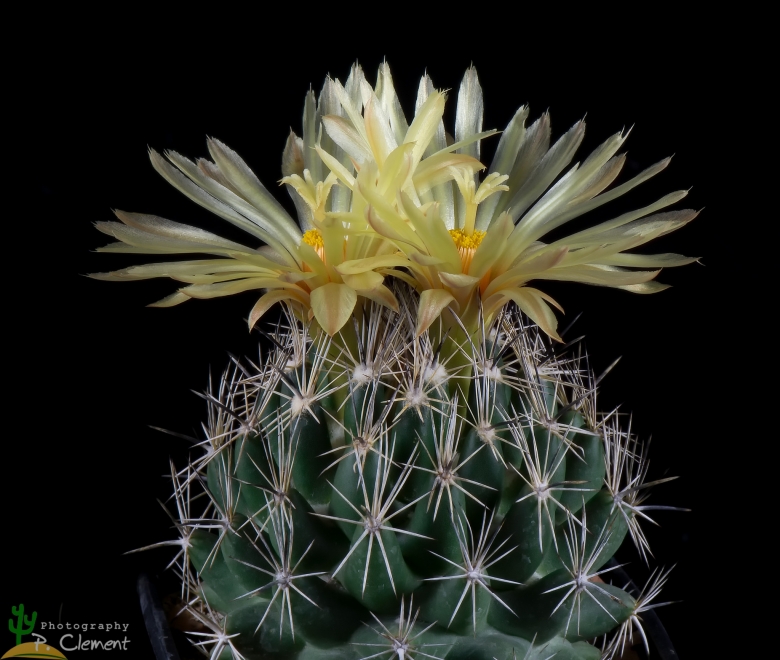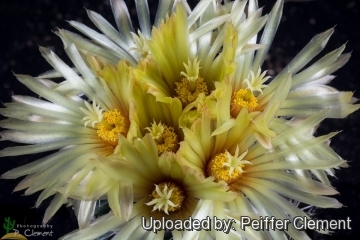




Your support is critical to our success.
Cactaceae (Britton & Rose) 4: 35 (fig. 32). 1923
Family: CACTACEAE

Origin and Habitat: Coryphantha nickelsiaeSN|10084]]SN|10084]] has a restricted range. It is found from the eastern slopes of the Sierra Madre Oriental, occurring in southern parts of Texas (United States) and in the Mexican states of Coahuila, Tamaulipas, and Nuevo León. (extent of occurrence is less than 5,000 km²)
Altitude range: Around 100-300 metres above sea level.
Habitat and Ecology: This species grows in semi-desert shrubland on the edge of the Chihuahuan Desert. The species is often found on limestone outcrops or in alluvial soils at the foot of hills and ridges and usually grows under other bushes. Plants may be solitary or may have many stems forming low mats. The population of C. nickelsiae is still large and stable and is abundant in places where there has not been any disturbance. However some habitat were C. nickelsiae grows has been lost in some areas, e.g., around Monterrey, due to urban expansion (settlaments and roads).
Synonyms:
- Coryphantha nickelsiae (K.Brandegee) Britton & Rose
- Coryphantha sulcata var. nickelsiae (K.Brandegee) L.D.Benson
- Mammillaria nickelsiae K.Brandegee
Coryphantha nickelsiae (K.Brandegee) Britton & Rose
Cactaceae (Britton & Rose) 4: 35 (fig. 32). 1923
Synonymy: 5
- Coryphantha nickelsiae (K.Brandegee) Britton & Rose
- Coryphantha sulcata var. nickelsiae (K.Brandegee) L.D.Benson
- Mammillaria nickelsiae K.Brandegee
- Coryphantha calochlora (hort.) Boed.
- Mammillaria calochlora hort.
ENGLISH: Nickels' Cactus, Nickels' Pincushion Cactus
SPANISH (Español): Biznaga-partida de Laredo
Description: Coryphantha nickelsiaeSN|10068]]SN|10084]] (Mamillaria nickelsae) is a solitary to densely cespitose cactus species, forming low mats with the stems nearly hidden by overlapping numerous, fine spines. Older specimens often have characteristic ribbonlike uppermost radial spines. Some authors consider this taxon to be a variety of Coryphantha sulcataSN|10084]]SN|10068]] (see Hunt et al. 2006).
Derivation of specific name: The epithet "nickelsiae" honors the Texas cactus collector Anna B. Nickels.
Stems: Deep-seated, aerial portion hemispheric or hemispherical or globose more or less flat-topped, tuberculate, pale to dark green and glaucous, 4 to 11 cm high tall, (4-)5-7 cm in diameter; older plants becoming purplish. Solitary (especially in western part of the range) or often branched from the axils of the lower tubercles near the surface of the ground and forming mats (mainly in the eastern part of the range).
Roots: Roots diffuse or short taproots; branches root adventitiously.
Tubercles: Bluntly conical, firm, rather broad at base, low, not densely arranged,soft, to 7-10(-13) mm long, becoming quite as broad and imbricated, almost hidden by the overlapping spines, sometimes with glands among the spines. Areolar glands seasonally conspicuous.
Central spine: Usually one (only in older specimens), sometimes absent, erect, straight or slightly curved downward, 11-16(-20) mm long, from all the upper areoles.
Radial spines: (13-)14-16(-20), crowded, slender, white, 8-23 mm long, at first simply spreading but afterwards bent back and interlaced with those of adjoining tubercles. The lowermost radial spines 8-10 mm long, the upper ones, at least on old plants, often longer, stouter, extending into the groove and forming a fascicle, the clustered fascicles making an upright tuft at the vertex, slender. All spines at first yellowish at base with dark reddish-brown tips, but afterwards bleaching white, others brownish to nearly black throughout.
Flowers pale: Flowers apical or nearly so, light yellow, 4.5-5(-7) cm in full expansion. Inner perianth-segments ca. 30 per flower, spreading, linear-lanceolate, acuminate, ca. 30 mm long. Outer perianth-segments entire. Filaments white or pale yellow. Anthers yellow to orange-yellow. Stigma lobes 5-8, white or cream, 2.5-8 mm long. This species flowers in summer (August to September).
Fruits: Nearly globular, or ellipsoid, grey-green or bright green (paler at base), (5-)18-23 mm long, 8-10 mm wide. Floral remnant strongly persistent.
Seeds: Small, orange, drying to brown, spheric to comma-shaped, 1.1-1.7 mm, finely and weakly raised-reticulate.
Bibliography: Major references and further lectures
1) Heil, K., Terry, M., Corral-Díaz, R., Guadalupe Martínez, J., Goettsch, B.K., Lüthy, A.D. & Dicht, R.F. 2013. Coryphantha nickelsiae. The IUCN Red List of Threatened Species 2013: e.T152538A648394. http://dx.doi.org/10.2305/IUCN.UK.2013-1.RLTS.T152538A648394.en. Downloaded on 11 May 2017.
2) Benson, L. “The Cacti of the United States and Canada.” Stanford University Press, Stanford, California.1982.
3) Dicht, R.F. and Lüthy, A.D. “Coryphantha Cacti of Mexico and Southern USA”. Springer-Verlag, Berlin. 2003.
4) Hunt, D., Taylor, N. and Charles, G. (compilers and editors). ”The New Cactus Lexicon”. dh Books, Milborne Port, UK. 2006.
5) SEMARNAT. 2010. “Norma Oficial Mexicana NOM-059-SEMARNAT-2010, Protección ambiental-Especies nativas de México de flora y fauna silvestres-Categorías de riesgo y especificaciones para su inclusión, exclusión o cambio-Lista de especies en riesgo. Diario Oficial de la Federación.”
6) Vargas, V.A. and Martínez-Ávalos, J.G. “Notas sobre nuevas localidades de Coryphantha nikelsiae (K. Brandegee) Britton & Rose.” Cactáceas y Suculentas Mexicanas 56(2): 1-4. 2011.
7) Edward Anderson “The Cactus family” Timber Press, Incorporated, 2001
8) James Cullen, Sabina G. Knees, H. Suzanne Cubey "The European Garden Flora Flowering Plants: A Manual for the Identification of Plants Cultivated in Europe, Both Out-of-Doors and Under Glass" Cambridge University Press, 11/Aug/2011
9) Nathaniel Lord Britton, Joseph Nelson Rose “Cactaceae: Descriptions and Illustrations of Plants of the Cactus Family” vol. 4 The Carnegie Institution of Washington, Washington 1923
10) Urs Eggli, Leonard E. Newton “Etymological Dictionary of Succulent Plant Names”. Springer, Berlin/Heidelberg 2010, ISBN 978-3-642-05597-3, S. 166.
11) Katharine Brandegee “Notes on Cacteae III.” In: Zoe. 5(2): 31, 1900 retrieved from http://www.biodiversitylibrary.org/page/568104#page/15/mode/1up 11 March 2017.
12) Coryphantha nickelsiae in: Flora of North America”}} FNA Vol. 4 retrieved from: http://www.efloras.org/florataxon.aspx?flora_id=1&taxon_id=242415317 11 March 2017

Coryphantha nickelsiae Photo by: Peiffer Clement
The gallery now contains thousands of pictures, however it is possible to do even more. We are, of course, seeking photos of species not yet shown in the gallery but not only that, we are also looking for better pictures than those already present. Read More...
Cultivation and Propagation: In culture Coryphantha nickelsiaeSN|10084]]SN|10084]] is without problems and regularly shows its large yellow flowers. It is a summer-growing species of easy cultivation but sensitive to overwatering (rot prone).
Growth rate: Slow growing. It needs about 8-12 years to reach the typical, definite outlook.
Soil: Grow it in an open sandy-gritty cactus compost.
Pots: It needs a relatively shallow pot to accommodate its fibrous roots and provide a very good drainage. They may stay in the same pot for many years.
Watering: Water in moderation, it prefer a completely dry place during winter. Mature individuals easily rot and die especially after planting so be extremely cautious with watering. Keep dry in winter or when night temperatures remain below 10° C. Water it less than average if in bigger pots.
Special need: Provide very good ventilation. Nearly all problems occur as a result of overwatering and poor ventilation, especially when weather conditions are dull and cool or very humid.
Fertilization: Feed them once during the growing season with a fertilizer specifically formulated for cactus and succulents (high potash fertilizer with a dilute low nitrogen), including all micro nutrients and trace elements diluted to ½ the strength recommended on the label. They thrive in poor soils and need a limited supplies of fertilizer to avoid the plants developing excess vegetation, which is easily attacked by fungal diseases.
Exposure: It will do its best with lots of sun and become stressed with inadequate light which could result in poor growth and unnatural shape.
Hardiness: It likes warmth (recommended minimum winter temperature 5° C) however plants kept perfectly dry can can survive low temperatures, approx. -5°, but for safe cultivation it is best to avoid freezing temperatures.
Use: It can be cultivated outdoors in raised beds, terraces if sheltered from winter rain.
Pests & diseases: These cacti may be attractive to a variety of insects, but plants in good condition should be nearly pest-free, particularly if they are grown in a mineral potting-mix, with good exposure and ventilation. Nonetheless, there are several pests to watch for:
- Red spiders: Red spiders may be effectively rubbed up by misting the plants from above.
- Mealy bugs: Mealy bugs occasionally develop aerial into the new growth and flowers with disfiguring results, but the worst types develop underground on the roots and are invisible except by their effects.
- Rot: Rot is only a minor problem if the plants are watered and “aired” correctly. If they are not, fungicides won't help all that much.
Propagation: Seeds. The seeds can be sown in pots of fine, well-drained sandy soil, any time during the spring when temperatures are warm. Cover the seeds with a fine layer of grit and water from below with a fungicide to prevent damping off. For the 1-2 weeks cover the pots with a sheet of glass/clear perspex to keep the humidity levels high. Remove the glass and replace it with light shade-cloth and mist once or twice a day for the next two weeks after which most seeds should have germinated. From then on mistings can be reduced to every second and then every third day as the little plants grow.
| Your Actions | |
|---|---|
| Back to Coryphantha index | |
| Back to Cactaceae index | |
 |
Back to Cacti Encyclopedia index |
Privacy stantement - Terms and conditions - How to cite - About us - Feedback - Donate




